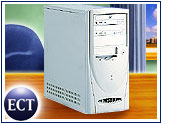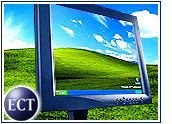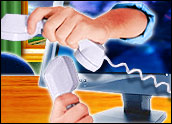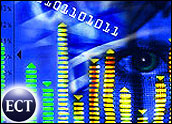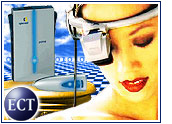
Beige boxes may still be the norm for a lot of desktop computer equipment, but people have been fooling around with design ever since they began making machines. Now that even Dick Tracy’s wristwatch videophone is a reality, what’s next for computers? While computer design has, by and large, stuck to the basic need for a protective enclosure, there have been some outstanding ideas and some duds over the years.
A few inspired designs have even redrawn the culture’s fashion landscape. Apple must rank high on anybody’s list of influential design innovators, from the original Mac Plus (cute, but still a beige box) to the translucent pastel of the iMac. Then they did it again with the hemispherical G4 iMac, and then with the sleek minimalism of the iPod.
Where will it end? With chips becoming smaller and faster, new materials littering lab benches worldwide, and wireless communications pervasive, computers are going to start showing up in odd guises. All of it, in the words of Neil Gerschenfeld of the MIT Media Lab, is about “breaking down the barrier between the bits and atoms.”
There are several main lines of innovation in IT design. These are the construction of computers in new ways using new materials; innovations in interface design (both input and display); the embedding of computing and communications technologies in “smart” household appliances and houses themselves; and “cyborg” projects, ranging from wearable technologies to actual integration of technology with our central nervous systems.
Small Is Beautiful
Miniaturization is often a critical goal. Take the new category of the ultra personal computer, now being abbreviated as “uPC.” Imagine a computer small enough to fit in your shirt pocket but packing the wallop of a full-featured desktop model. A San Francisco-based company called OQO intends to release such a machine later this year with a price rumored to be somewhere above US$2,000.
But this is simply the shrinking of existing concepts. At heart, the changing shape of computers is driven by innovation in fundamental technologies, such as transistors or coatings. For example, at MIT’s Media Lab, researchers are busy on, in their own words, “an unusual range of disciplines,” such as software agents, machine understanding, human and machine vision, speech interfaces, affective computing, object-oriented video, interactive cinema and new approaches to spatial imaging and nanomedia.
This is extreme stuff. “Our ultimate goal,” said the MIT Media Lab, “is to build a desktop printer capable of printing a fully functional computer onto a piece of paper or plastic.”
One less avant-garde IT idea is that of the smart home: embedding processors and Internet connections in various household objects and even in the house itself. Despite the relative maturity of the technologies involved, we have not seen a groundswell of acceptance yet.
Still, the gadgets are there — from several brands of “smart fridge” that can tell you when your milk’s gone off to National’s microwave oven with 365 recipes stored in memory, to automated vacuum cleaners such as the Roomba or Electrolux’s Trilobite.
Face to Interface
“A good interface is one that’s transparent,” says Shumin Zhai, a member of IBM’s user systems ergonomic research group. “That means it is so good you don’t notice it, allowing you to fully concentrate on the task at hand. That’s what we’re after.”
Much of the coming innovation is in the man-machine interface, both input and display. Most of us are still stuck with keyboards, but now we can get flexible ones that roll up to fit in a corner of our briefcases. The lack of a decent keyboard has always been a drawback of PDAs and mobile phones.
A company called Canesta has the answer, which it’s offering to manufacturers: a small system mounted in the PDA or phone that projects an image of a full-size keyboard on any convenient flat surface. Type on it, and the other half of the system uses a kind of infrared “radar” to sense your finger movements and translate them into keystrokes internally at 50 words per minute.
Electronic paper has long been a holy grail of designers. The notion of carrying just a few sheets rolled up in your pocket, onto which you can download any print content, has had powerful appeal. Nothing practical is available yet, but Phillips recently showed a 12-centimeter-square sheet prototype containing 80,000 grayscale pixels that refresh in about a second. They expect it to be mass-produced “within a few years.”
Wearables, Mediated Reality and Beyond
Interface design shades over into wearable devices. Most involve an eyeglass-mounted display, allowing computer information to be superimposed on reality. Commercial products from Xybernaut, Microvision and others, available today and able to superimpose virtual diagrams onto real-world projects, are aimed at service technicians. Most such displays use LCDs, but Microvision’s Nomad actually uses a tiny, low-powered laser to write images directly on the user’s retina.
Researchers at the University of Toronto’s Humanistic Intelligence Lab, under the leadership of Steve Mann, go further. Their wearable, called EyeTap, incorporates a video camera that “sees” what the user does but then processes those images to provide added information — what they call “mediated reality.”
According to Daniel Chen, the lab’s corporate development officer, uses might include surgery, military action, blocking out advertisements or just meeting a casual acquaintance. In these scenarios, the software would recognize a face and superimpose a nametag and notes over the user’s view. “We’re not talking about a maintenance manual; we’re using the computer’s processing capability to improve your life,” he says. Chen is now looking for industry partners to develop real-world products.
But few, if any, have gone as far as Britain’s Kevin Warwick of the University of Reading. He might be the first true cyborg, because he has had electrode arrays and silicon transponders inserted into the nerves of his arm, allowing his body to communicate directly with computers to drive an artificial arm and a wheelchair, and to communicate via the computer with his similarly equipped wife.


